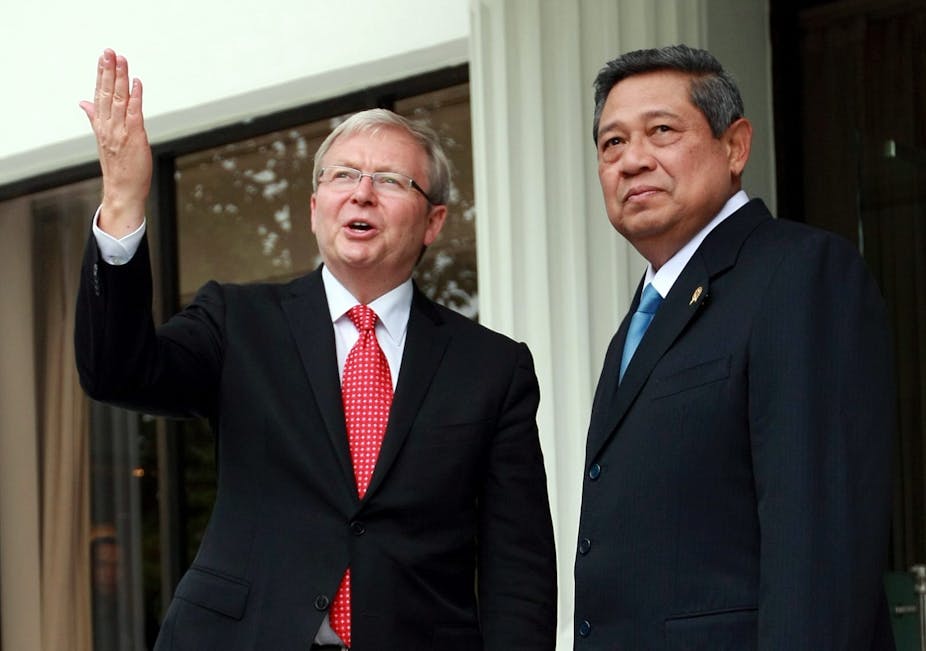Today’s Indonesia-Australia Leaders’ Meeting - where Australian prime minister Kevin Rudd will meet with Indonesian president Susilo Bambang Yudhoyono - takes place against a backdrop of the asylum seeker problem, which continues to dominate Australian politics.
But what is the all-important view from the Indonesian side of the debate, and what factors inform that view?
When I studied at the University of Sydney in 1990s, Indonesia was still under the authoritarian regime of Suharto and Australia was led by prime minister Paul Keating. In 1996, John Howard’s Coalition government came to power and with it a different style of Australian engagement with Asia emerged.
Keating’s legacy in reorienting Australian foreign policy is still remembered by many people in Indonesia, especially by students of the 1990s who experienced a positive image of Australia’s engagement into Asia. The Keating-led nuanced understanding of Australia in Asia as “multicultural” encouraged the belief in Asia of Australia as an “open” country. However, Howard came to power with a very clear message to foreigners. He campaigned on the platform of strength and security, defending Australia’s shores from all.
How did Keating’s policies of “openness” and multiculturalism conflict with what happened during Howard’s term in office? Under Howard, the issue of and rhetoric around “boat people” and “illegal migrants” - particularly from poor and Islamic countries such as Iraq, Afghanistan and Pakistan - became the target of Australian foreign policy.
In contrast, Australia’s neighbour Indonesia is a big and “new” democratic country in the world after the reformation in 1998. One of the biggest issues we face in Indonesia is about Indonesian migrant workers - both legal and illegal - moving to many countries including Malaysia, Hong Kong and the Middle East, especially in Saudi Arabia. We also have problems with ethnic group mobility between provinces, which have led to violent conflicts between Indigenous groups and people from different parts of Indonesia.
How Indonesia looks at the issues of illegal migrants, asylum seekers and human trafficking is informed by the above background. Further, as a country with thousands of islands - many of which are very remote from government control - there exists a limited budget on security for Indonesian coastal areas. Many “boat people” intentionally or unintentionally stop in small harbour cities south of Java and east of Nusa Tenggara such as Sukabumi, South Cianjur and Florest. These are the best transit places for asylum seekers to reach Australia.
The Indonesian government does not have the money to return these asylum seekers to their country of origin. The concentration of the Indonesian government is focused mainly on the Malacca Strait and the South China Sea, areas which are very important for international trading. Asylum seekers, however, use the Indian Ocean, which the Indonesian government does not have as much ability to control. There is also a “mafia” of organised people smuggling, facilitating the asylum seekers’ journey to Australia.
There are some solutions to the asylum seeker dilemma. The Australian and Indonesian governments and the countries of origin of asylum seekers have to cooperate multilaterally to prevent illegal trafficking. The UN High Commissioner for Refugees (UNHCR) also has to be more precise in defining the difference between refugees/asylum seekers and the illegal migrants.
Finally, it is important that policy is created between Indonesia and Australia jointly to build the capacity to control and patrol their coastlines. The Australian government has to work together with the Indonesian government to handle refugees and illegal migrants since Indonesia has now become the “door” to Australian shores. Especially on the Indonesian side, it will require increasing the capacities of not only the police but also the navy.
The idea to build a military base on the Cocos Islands as the first line of “defence” of Australian soil will further burden the Indonesian government’s ability to handle asylum seekers. In practice, the Singaporean, Malaysian and Indonesian governments are usually not willing to divert attention towards asylum seekers even though the policies of those governments are similar to that of the Australian government.
There are still some questions open for debate in Indonesia. Is there a reason that the most populous Muslim country in the world - which is open to the process of democratisation, despite struggles with violent conflict - is considered a threat to Australia? Should there be a role for the Indonesian media to play in building the bridge between Australia and Indonesia on issues of human trafficking?
Whether or not Australia and Indonesia co-operate further to restrict the numbers of asylum seekers leaving from Indonesia may yet be answered at today’s summit. Yet the Australian government too needs to seek new ideas on how to work productively with new democratic countries like Indonesia.
Indonesia and Australia now have to develop dialogue and policy towards asylum seekers with mutual understanding and mutual respects for their national interest and national pride. Both countries await any results from today’s summit.

